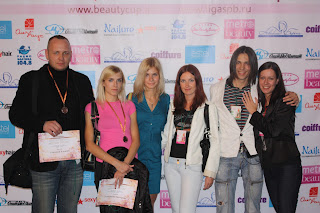Questions and answers.
What kind of applications should be pinched?
Sculptured acrylic/gel, acrylic on tips.
Why should we pinch the nail?
Proper pinching of the nail enhancement makes the perfect architecture of the nail and gives it elegant esthetic look. But the main function of pinching is strength and durability.
Half cylinder construction is much more resistant to deformation that the flat one.
The curve of the lower arch (sometimes called C-curve), or the concave is measured in percents of the whole circle. 50% means half of the circle, and 30% is almost one-third.
For salon nail enhancement it is recommended to make 25-35% concave.
For competition nails it is required to be at least 40% and above.
Excessive pinching can cause cracks and onycholysis!
Onycholysis refers to the detachment of the nail from the nail bed, starting at its distal and/or lateral attachment.
How should I pinch the nail correctly?
Catch the moment
When the product is almost polymerized but it is still a bit soft, than this is the right moment to start pinching. You should start to pinch the nail right from the place where the artificial extension edge begins. You can’t pinch the nail in the area where there is a natural nail bead underneath. If the client feels pain, that means you’re doing something wrong.
Pinching should NOT HURT!
What should I use for pinching?
You can use your thumbs (if you got enhancement on it) or special pinching tools. The main thing is not WHAT you use; it is about HOW you use it. Pinch the nails gently, always control the look-and-feel of your clients, and stop pinching if it causes pain.
To sum it up, pinching the nail gives it excessive break-proof resistance and nice elegant look. But improper pinching will cause exactly the opposite.
So, please, make sure that you have enough qualification to pinch the nails and not to hurt the client. Proper education and training courses can help you with that, ask your tutor to show you the technique of nail pinching.
On the picture above you can see the nails that are not pinched. They look wide and kind of heavy-weight.
What kind of applications should be pinched?
Sculptured acrylic/gel, acrylic on tips.
Why should we pinch the nail?
Proper pinching of the nail enhancement makes the perfect architecture of the nail and gives it elegant esthetic look. But the main function of pinching is strength and durability.
Half cylinder construction is much more resistant to deformation that the flat one.
The curve of the lower arch (sometimes called C-curve), or the concave is measured in percents of the whole circle. 50% means half of the circle, and 30% is almost one-third.
For salon nail enhancement it is recommended to make 25-35% concave.
For competition nails it is required to be at least 40% and above.
But the main thing in pinching is that it should be properly done!
Excessive pinching can cause cracks and onycholysis!
Onycholysis refers to the detachment of the nail from the nail bed, starting at its distal and/or lateral attachment.
How should I pinch the nail correctly?
Catch the moment
When the product is almost polymerized but it is still a bit soft, than this is the right moment to start pinching. You should start to pinch the nail right from the place where the artificial extension edge begins. You can’t pinch the nail in the area where there is a natural nail bead underneath. If the client feels pain, that means you’re doing something wrong.
Pinching should NOT HURT!
What should I use for pinching?
You can use your thumbs (if you got enhancement on it) or special pinching tools. The main thing is not WHAT you use; it is about HOW you use it. Pinch the nails gently, always control the look-and-feel of your clients, and stop pinching if it causes pain.
To sum it up, pinching the nail gives it excessive break-proof resistance and nice elegant look. But improper pinching will cause exactly the opposite.
So, please, make sure that you have enough qualification to pinch the nails and not to hurt the client. Proper education and training courses can help you with that, ask your tutor to show you the technique of nail pinching.
On the picture above you can see the nails that are not pinched. They look wide and kind of heavy-weight.

























